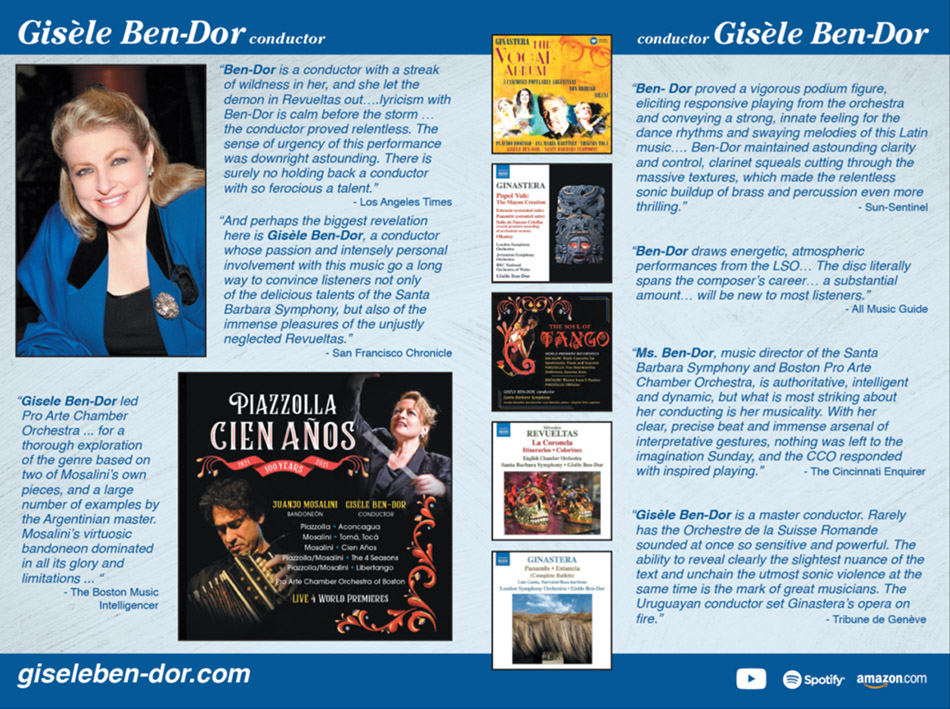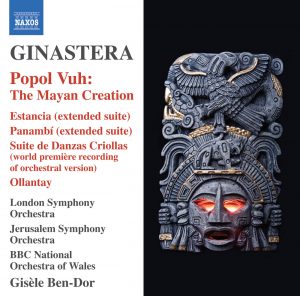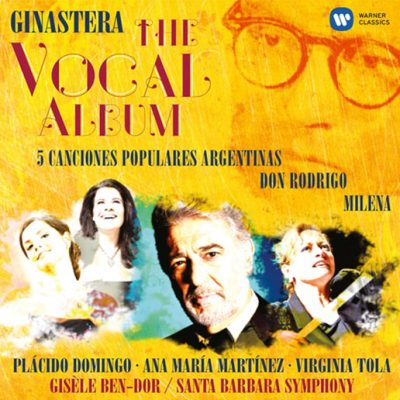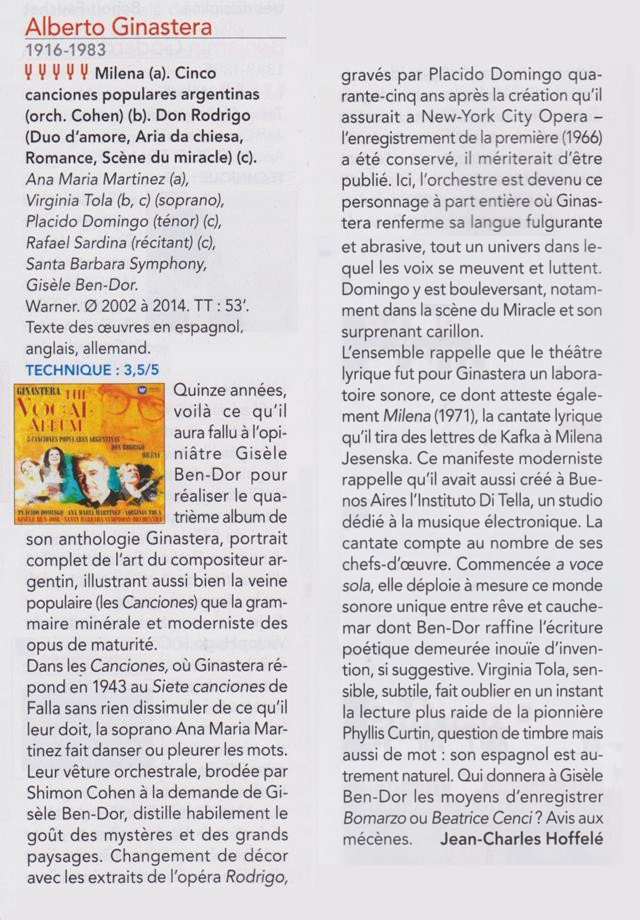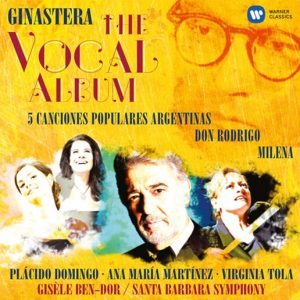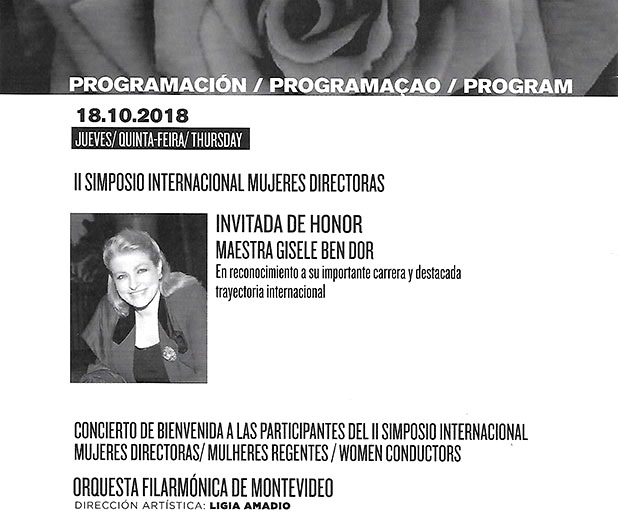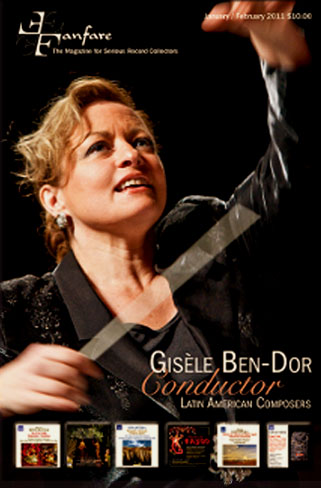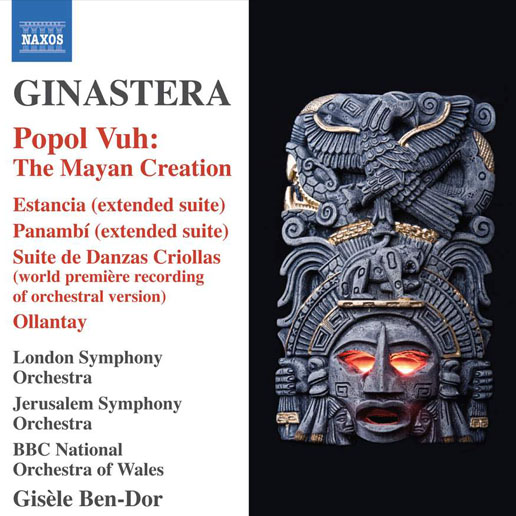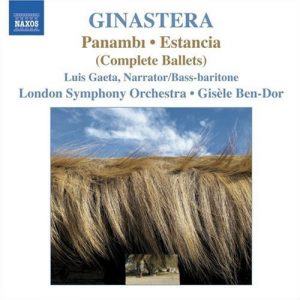RELEASED 2021
“Cien Años”
“One Hundred Years”
A celebration of Piazzolla’s 100 Anniversary
Gisèle Ben-Dor, Juanjo Mosalini
Boston Pro-Arte Chamber Orchestra
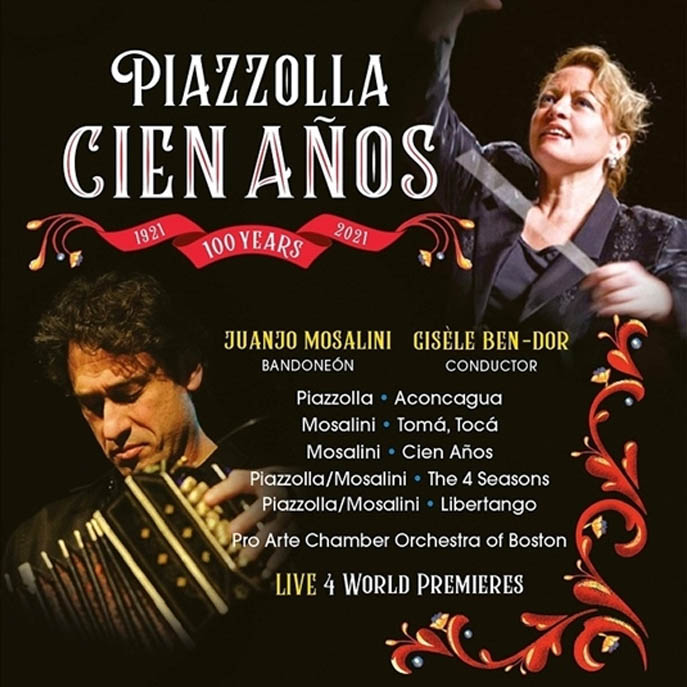
Piazzolla: Cien Años. Mosalini. Ben-Dor, Pro Arte. Centaur.
Bandoneón virtuso Juanjo Mosalini, also an accomplished composer and arranger, is joined by Gisèle Ben-Dor for another release marking Astor Piazzolla’s 100th birthday year. The dualities of Piazzolla’s music are underscored—classical discipline vs. spontaneous impulse, Baroque angularity vs. the sensual melancholia of nuevo tango. The program opens with a performance of Pizzolla’s 1979 Concerto for Brandoneón that, thanks to Mosalini’s fluent virtuosity and conductor Ben-Dor’s propulsive support, is as effective as any I’ve heard. Four world premiere recordings follow the Concerto, including two original works by Mosalini. Take It, Play It is dedicated to Piazzolla’s electric guitarist, Tomás Gubitsch, and Cien Años, commissioned by Ben-Dor, honors Mosalini’s grandfather and also serves to mark the Piazzolla centenary. Mosalini’s music channels the style and mood of the earlier Argentinian composer without seeming imitative. The album’s highlights are two Mosalini arrangements. The Four Seasons of Buenos Aires is a 24-minute suite based on four stand-alone pieces conceived for Piazzolla’s quintet, and the disc closes with an exhilarating version of Libertango. The program has been vividly recorded by Brad Michael with the bandoneon forward in the mix, though not oversized.
the absolute sound, October 2021, Andrew Quint
GRAMOPHONE – Piazzolla: Cien Años
This programme may have been designed as a centenary tribute to Astor Piazzolla but it’s Juanjo Mosalini who steals the limelight. Mosalini’s vividly characterised account of the Bandoneón Concerto is viscerally exciting, and not merely because his playing in the outer movements is so propulsive and rhythmically taut – he drives the finale hard, seeming to leap through the semiquaver licks – but also because his generously long-breathed phrasing in the slow movement generates such a powerful emotional undertow.
Even more impressive, perhaps, is Mosalini’s arrangement of The Four Seasons of Buenos Aires. There have been other adaptations of these works for string orchestra, including a daringly free recomposition by Leonid Desyatnikov, popularised through Gidon Kremer’s Nonesuch recording (5/00), and Roberto Molinelli’s more respectful yet equally effective version, recently recorded by the Cappella Gabetta (Sony, 7/19). Mosalini’s falls somewhere between the two; he’s done extensive rewriting yet it’s in a style that’s in tune with the originals. Indeed, Mosalini highlights the music’s cinematic qualities, which seems fitting for Piazzolla, who wrote dozens of film scores over the course of his career. What’s unusual here (besides the fact that the primary solo part is for bandoneón rather than violin) is that Mosalini has sewn the four separate pieces together to form a single 25-minute movement. The stitching is deftly done (listen, say, at 17’06”, where he subtly joins ‘Winter’ and ‘Spring’), although the result cannot disguise the fact that – engaging as it is – this is a suite rather than a through-composed entity.
Mosalini also proves to be a fine composer in his own right. His debt to Piazzolla – and the Argentine folkloric style of Piazzolla’s teacher Ginastera – is readily discernible in the toccata-like Tomá, tocá (‘Take it, play it’), and while Cien años doesn’t really stake out new territory, there’s something distinctive in the score’s harmonic restlessness and lyrical ache. Both works are skilfully crafted, in any case, and the entire programme is performed with gusto. Boston’s cooperative chamber orchestra not only play with élan for Gisèle Ben-Dor, they’re with Mosalini every step of the way.
Author: Andrew Farach-Colton
Piazzolla Cien Años: Lord of the Tango@100
Raul Da Gama, NOV 5, 2021
…….nuevo tango continues to burn, now seemingly with an eternal flame, one hundred years on. ….. celebrated Uruguayan conductor Gisèle Ben-Dor, a fierce champion of South American music composers. Her brilliant work with the Pro Arte Chamber Orchestra of Boston features the prodigious composer and bandoneonist Juanjo Mosalini, and also features world premieres of works by both Piazzolla and Mosalini.
Piazzolla Cien Años – Juanjo Mosalini – Gisèle Ben-Dor – Boston Pro Arte Chamber Orchestra
Gisèle Ben-Dor is a conductor who clearly dines far further afield than many of her contemporaries, offering more than the meat-and-potatoes repertoire offered by a majority of her peers. Her interpretation of Mr Piazzolla’s great work “Aconcagua: Concerto for Bandoneón [1979]” gives new meaning to the phrase: “a sense of time and place”. Moreover, in these works, Ms Ben-Dor conveys the sense of Piazzolla being a distinctively Argentinean composer on the scale of Ginastera. In the concerto, for instance, she brings a special alertness to the pointing of phrase and building of form that makes sense of the composer’s unique way with tango.
…it is Ms Ben-Dor who must be principally credited for the deftness that she brings to the movements……, with a flexible but coherent movement takes her time to draw out the second “Moderato” movement, which steals in with sensuous reticence.
The manner in which each of Mr Piazzolla’s picturesque episode and naturalistic detail is called to mind, the synchronicity of motion and expressive intent within the concerto as well as in the other works is passionately conveyed.
This recording is one of the most memorable of all those that now serve to mark the centenary celebrations of the Argentinean maestro, not simply by the grand scale of it all, but by the sizzling performances, the magnificent retelling of the Piazzolla story, by painting vivid pictures with picture and painting coming dramatically alive as if in the day when the great one himself inhabited these pieces.
Raul Da Gama
Based in Milton, Ontario, Canada, Raul is a poet, musician and an accomplished critic whose profound analysis is reinforced by his deep understanding of music, technically as well as historically.
Planet Hugill – A world of classical music
Our final disc celebrates Piazzolla both with his own music and with a composer inspired by him. Uruguay-born American Israeli conductor Gisele Ben-Dor conducts Juanjo Mosalini (bandoneon) and the Pro Arte Chamber Orchestra of Boston on Centaur Records (CRC 3844) in Piazzolla’s Concerto for Bandoneon, Las Cuatro Estaciones Porteñas and Libertango, the latter two in Mosalini’s own arrangements, plus two of his own pieces. Mosalini is Argentine-born but brought up in Paris where is father, a distinguished Argentine musician, was in exile.
This performance takes us, I think, a bit closer to the original concept for the concerto. There is more of an edge, less of a luxurious cushion to the orchestra and the players relish the moments where Piazzolla turns them into a real tango-band. For his part, Mosalini plays the bandoneon to the manner born and makes the instrument sophisticated whilst preserving the vigour, roughness and edge that is needed. This is music which has been brought into the concert hall, but still with a whiff of the bar room.
Mosalini’s own Cien Años was composed, not for Piazzolla but for his own grandfather, yet it fits here and is paired with Mosalini’s Toma, Toca dedicated to Piazzolla’s former electric guitar player Tomas Gubitsch. Both engaging and examples of the continuation of Piazzolla’s tradition.
Las Cuatro Estaciones Porteñas features Mosalini’s new arrangement for bandoneon and orchestra, and it is clear quite how each version re-invents the piece as there are moments when you wonder whether this is the same music. As with the concerto, there is more edge here, rhythms are tighter and those sharp-edged tangos are rarely far away whilst you can feel that smoky bar-room. I really enjoyed this performance and will return to it, partly because you feel that for all their Western European-style sophistication, the musicians are willing and able to get down and dirty too.
And we end with a terrific version of Libertango in Mosalini’s own arrangement again for bandoneon and strings.
I am still waiting for that disc where a modern quintet gets down and dirty with Piazzolla’s music. Perhaps that is no longer possible, we simply listen to it with too sophisticated ears.
Review by Robert Hugill
A marvelous Piazzolla centenary tribute
Reviewed in the United States on August 12, 2021
Piazzolla: Cien Años (Centaur) commemorates the 100th birthday of the Argentine bandoneón virtuoso and composer Astor Piazzolla (1921-1992). Bandoneón soloist Juanjo Mosalini joins the Pro Arte Chamber Orchestra of Boston, under the direction of its Conductor Emerita, Gisèle Ben-Dor. The recording opens with Piazzolla’s bandoneón concerto, Aconcagua. Four world premiere recordings follow, all, like Aconcagua, scored here for bandoneón and orchestra. First is Mosalini’s vibrant Tomá, Tocá (Take It, Play It), dedicated to Tomás Gubitsch, an electric guitarist who performed with Piazzolla. Mosalini composed the reflective Cien Años (One Hundred Years) in memory of his grandfather. The timing of the work’s creation also coincides with the Piazzolla centenary. Mosalini’s arrangements of Piazzolla’s The Four Seasons of Buenos Aires (Cuatro Estacíones Porteñas) and Libertango conclude the disc. Cien Años and the arrangement of The Four Seasons were both commissioned by Ben-Dor. Mosalini is a superb instrumentalist, a technically brilliant artist whose playing is both unfailingly kinetic, and suave in tone and phrasing. It is seductive music making; and isn’t that perhaps the highest compliment one can pay to an interpreter of tangos? Mosalini layers improvisational elements into Piazzolla’s three-movement Aconcagua, certainly appropriate for the character of this music, and highly effective. Both Mosalini’s Tomá, Tocá and Cien Años are brief, single-movement works that feature a convincing and beguiling synthesis of various popular and classical elements, very much in the Piazzolla tradition. Piazzolla composed the movements of the work now known as The Four Seasons of Buenos Aires separately, and over a period of about 5 years. It is now known as a unified work (sometimes a concert companion to Vivaldi’s Le quattro stagioni) and has been arranged for various complements of instruments. In his arrangement for bandoneón and orchestra, Mosalini adds connective tissue so that that the four movements are performed without pause. It’s a lovely effect, and one that fits into the work’s 25-minute time span without strain. The disc concludes with a stirring rendition of one of Piazzolla’s signature works, Libertango. Conductor Gisèle Ben-Dor has long been a superb advocate for Latin-American music. Here, she leads the Pro Arte Chamber Orchestra in performances that are teeming with color, style, and irrepressible energy. The recording, which positions the listener in close proximity to the artists (but not oppressively so), packs considerable impact. Both Pablo Aslan and Ben-Dor contribute lively and informative commentary for the CD booklet, which also includes artist bios. A worthy and highly engaging centenary tribute to the father of the Tango Nuevo.
Recommended, Ken Meltzer
5.0 out of 5 stars
A superb centenary tribute to the great tango master
Reviewed in the United States on August 9, 2021
Just as the nocturne and the mazurka are synonymous with Chopin, the tango instantly brings to mind the name of Astor Piazzolla, whose centenary is being celebrated by this vibrant album titled simply Cien Años. Not many major composers adopted the tango (Stravinsky’s version in L’histoire du Soldat is so cool and detached it betrays the very nature of tango). It speaks volumes about the remoteness of South America from the minds of classical composers that the dumka and polonaise drew immense attention by comparison.
But once Piazzolla was discovered outside Argentina, no one has attracted more affection from a wide range of classical performers. The eroticism so dominant in tango dance programs doesn’t often seep through when Piazzolla makes it to Carnegie Hall, but he has so much to offer melodically, harmonically, and rhythmically that Eros is a side issue. No popular dance form besides the Viennese waltz has been as lucky in the sophistication that one genius brought to it. Piazzolla’s signature is indelible, and his music survives a wealth of arrangements and “derangements” (to borrow Thomas Beecham’s witty term) without losing its essence.
For all that, Piazzolla’s tangos have perhaps been passed from hand to hand too much for their own good, outside Argentina at least. Their foster homes in the U.S. and Europe haven’t always been congenial, which makes this new release stand out for sounding and feeling like the real thing. Piazzolla’s instrument was the bandoneon, and it occupies center stage on the program, played with undeniable charisma by Juanjo Mosalini, a recognized master of the instrument who was born in Buenos Aires in 1972 and whose career has an international reach.
In Western folk and popular music there are many varieties of bellows-driven reed instruments, each with its own character. The tango, to my ears, is inconceivable on Lawrence Welk’s accordion. Like the harmonica, the bandoneon is intimate and personal, but the harmonica in erotic mode is fairly laughable. The bandoneon has its own come-hither allure, and it can weave a melody as sinuously as the bodies of impassioned tango dancers. Piazzolla studied in Paris with Nadia Boulanger, and he created Nuevo tango as a malleable genre that fluidly crosses over between the concert hall and the dockside bars and clubs of Buenos Aires.
A beautiful aspect of Mosalini’s playing is his ability to inhabit every world Piazzolla’s music takes us to, from the swanky to the gritty. The most urbane work here is the Concerto for Bandoneón, often just called Aconcagua. The music is relatively refined, the earthiness and growl of the bandoneon tempered for civilized purposes. But tango is still palpable, as explained in the readable and helpful program notes: “Many of Piazzolla’s compositions begin with a riff, a jagged theme that repeats insistently. Most of them have an air of milonga, the ancestral music of Buenos Aires.” As related to the bandoneon concerto, “the underlying pulse undulates in groups of 3, 3, and 2 right from the opening statement.”
This off-balance rhythm gives tango its signature, and in the most famous work here, The Four Seasons of Buenos Aires, Piazzolla puts the basic rhythmic pulse through endless, fascinating changes, greatly aided by Mosalini’s arrangement for bandoneon and chamber orchestra—he adds punch to the accents and imbues the music with touches of his own personality. There are other arrangements by him on the disc, listed as world premieres, the most dazzling being an original composition, Tomá, Tocá, a bravura variant of a toccata in which he plays a Moto perpetuo in sixteenth notes while the tango melody is punched out as if by a third hand. Another of his pieces, Cien Años, the album’s title work, is tenderly reminiscent of smoky Parisian cafés at midnight, nodding to that strain of Piazzolla’s imagination.
As remarkable as Mosalini is, such an imaginative release owes just as much to , Gisèle Ben-Dor, the emeritus conductor of the Pro Arte Chamber Orchestra of Boston. Not only does she lead each piece with sympathy and a knowing hand, keeping the tango pulse alive and vibrant, but Ben-Dor commissioned Mosalini’s Cien Años and his arrangement of The Four Seasons. The latter alone is enough to make this release a significant addition to the burgeoning Piazzolla discography, given is originality and its inspired take on the original. All lovers of Piazzolla will be grateful to Ben-Dor for a project that has wound up being a superb listen.
Warmly recommended as one of the liveliest, most entertaining albums of the year.
Huntley Dent
The Boston Music Intelligencer
a virtual journal and essential blog of the classical music scene in greater Boston
Lee Eiseman, publisher; Robert Levin, advisor; David Moran, assisting editor; Bettina A. Norton, emerita editor
JANUARY 14, 2020
Pro Arte Tangos in the Cambridge Pampas
The art of Astor Piazzolla comes one’s way more frequently than not in a form of an encore, leaving the listener both enjoying the piece and wondering whether having heard one Piazzolla, one has heard them all. Gisele Ben-Dor led Pro Arte Chamber Orchestra, and tango nuevo specialist Juanjo Mosalini for a thorough exploration of the genre based on two of Mosalini’s own pieces, and a large number of examples by the Argentinian master. Mosalini’s virtuosic bandoneon dominated in all its glory and limitations at Sanders on Sunday.
Two premieres of his own pieces for bandoneon and strings began the concert. First, a good-natured and pleasant tribute to Mosalini’s friend and colleague Tomas Gubitsh, titled Tomá, Tocá took proper advantage of the bright reed accordion’s one-note-at- time expressiveness in long narrative lines. Then Cien Años celebrated the generations of bandoneon players in the composer’s direct lineage, as well as the instrument’s role in birth, and then rebirth of tango. After the promising beginning, many button bellows went silent, as concertmaster Kristina Nilsson’s long, expressive violin solo took complete possession of the stage. The main hero returned, joining the orchestra and recapturing the violin’s theme and spirit. If Mosolini had been making a point that this expandable black box can compete with the violin as the lyrical hero, the argument was rather persuasive.
Piazzolla’s Four Seasons of Buenos Aires had originated with Summer before growing to four separate pieces, first played by the composer’s tango quintet, which, of course, included bandoneon; lately it has really taken wing in a number of arrangements, most famously by Leonid Desyatnikov to a Gidon Kremer commission. Kremer programmed it along with Vivaldi’s Quattro Stagioni, and the arrangement not only quoted the familiar Inverno downpours, but also in general thrived on string textures and perfect articulation of themes. For this performance, Moselini attempted to restore the primacy of the bandoneon, and to this reviewer’s ears, Seasons suffered for that. The instrument’s role as a staccato accompaniment did not play up its best capabilities and became somewhat tiresome. It lost the urgency and some of the intensity of the string arrangements, and became less soulful, even though leaders of string sections of Pro Arte played their respective solos beautifully. I did not catch any Vivaldi’s Winter quotations in Piazzolla’s Summer either. But maybe there was little need: as I look at my weather app now, the temperature in Buenos Aires in the midst of their warm season is lower than it was in Harvard Square during this warm January 12th afternoon. Get a quote from a climate scientist about that.
Though Libertango often unfolds in slow and improvisational buildup that culminated in the catchy theme, yesterday we heard a much more streamlined and uniform take that felt somewhat short of the full range of this crowd pleaser’s expressive potential. Again the bandoneon came across as a bit domineering.
Then came Piazzolla’s magnum opus, the Aconcagua Concerto. Here the harmoniousness between bandoneon and the world gloriously returned. Timpani and percussion, along with a harp and a piano, took the burden off of the instrument that previously tried to carry all rhythmic and accompaniment duties. In the slow movement, slow brooding bandoneon lines over harp and piano accompaniment led to haunting sonorities you would not hear with any other combination. Gisele Ben-Dor achieved a strings texture that breathed like a single vocalist. This great interpretation of the concerto restored one’s appreciation of the balanced place of the tango nuevo patriarch in this essential repertoire.
As an encore, Pro Arte delivered a hot renditions of Por una cabeza by Carlos Gardel Oblivion by Piazzolla, assuring the gleeful crowd that tango viejo was not about to roll over either.
Boston Classical Review
Andrew J. Sammut
JANUARY 13, 2020
Pro Arte Orchestra explores the world of Piazzolla and the bandoneon
Bandoneonist Juanjo Mosalini was the soloist in the Pro Arte Chamber Orchestra’s program Sunday at the Sanders Theatre.
Astor Piazzolla explored modern harmonies and extended forms with his tango ensembles, bringing a new expressiveness to the music of his native Argentina. His tango-infused compositions in turn expanded the rhythmic and melodic vocabulary of the classical repertoire.
Pro Arte Chamber Orchestra of Boston and conductor Gisè le Ben-Dor celebrated Piazzolla’s distinct legacy in their own unique program on Sunday at Sanders Theatre. “Nuevo Tango” featured guest soloist Juanjo Mosalini in works by Piazzolla as well as premieres of the bandoneonist’s own compositions and transcriptions of Piazzolla’s music.
The bandoneon-relative of the much-maligned accordion-is rarely heard in orchestral settings. Yet it is synonymous with both Argentinian music and the late Piazzolla’s own performances.
Piazzolla’s Aconagua, Concerto for Bandoneon was the final work on the program but the most powerful performance of the afternoon. Piazzolla’s publisher titled the 1979 concerto after the highest mountain peak in the western hemisphere to signify it as the summit of the composer’s work.
Piazzolla studied with the likes of Nadia Boulanger and Alberto Ginastera, and Aconagua synthesizes that expert handling of harmony, counterpoint, and other compositional techniques with the diverse themes, moods, and rhythms of tango Piazzolla played and lived his whole life. The concerto is scored for chamber orchestra with percussion including piano and harp, and comprises two intense outer movements surrounding a wistful middle section.
Pro Arte burst into the opening Allegro marcato with bold declaratory phrases. The augmented instrumentation strengthened orchestral textures while clarifying the rhythmic profile. Ben-Dor patiently expanded the central Moderato from a morose reflection into a throbbing outburst. Orchestral entrances behind the soloist stayed gentle and flowing. The conductor also maintained a driving clip in the final Presto. A slow seductive ground rhythm emerged, with the string players striking the fingerboards and backs of their instruments, before a roaring march closed a concerto that earned applause after each movement.
Mosalini demonstrated the dexterity and passion of a concert virtuoso throughout. His tender a cappella asides in the first movement and undulating phrases in the second felt like warm serenades. In the Presto, Mosalini’s crisp phrase endings and drawling slides between notes made for a clever and convincing dramatic compromise between the movement’s anxious first section and lazy second theme.
Sunday also marked the world premiere of Mosalini’s arrangement of Piazzolla’s The Four Seasons of Buenos Aires. An homage to Vivaldi’s Four Seasons transplanted to the capital of Piazzolla’s homeland, these “seasons” were composed at different points between 1965 and 1970. He would perform them with his quintet but rarely together. Mosalini’s version not only makes the bandoneon a soloist, but it connects the four separate works into one lengthy and intense tour.
“Summer” started the work with an earthy feel. Mosalini leaned into sour crushes of notes on top of the string’s pop and thrust, with Ben-Dor’s slight push bringing out the melodic side of the accompaniment. Finely articulated phrases from both Mosalini and principal cellist Steven Laven marked the peaceful moments of “Autumn” and “Winter.” Yet scratchy glissandos, anxious tremolos and the string players knocking catchy beats on their instruments were a thread throughout Mosalini’s long suite. “Spring” packed soloist and ensemble alongside one another in close contrapuntal phrases. With the bandoneon’s wider timbre and louder volume, the effect was less differentiated. The angular minor key groove still came through.
Other parts of the program emphasized harmony and texture over rhythm. Tomá, Tocá, Mosalini’s tribute to a guitarist colleague, began with a swirling orchestra before rapid-fire bandoneon licks over a reiterated pizzicato dance rhythm. The overall feel was of a controlled exhibition tango rather than a visceral nightclub outing, heightened by a cool glaze of violins in the middle.
Creaking dissonant strings introduced Mosalini’s Cien Años, a commission by Ben-Dor for Pro Arte heard in its world premiere on Sunday. Based on a sad motif that seems to climb only to inevitably fall, Mosalini’s organ=like tones and syncopated pumps over Argentine milonga and tango accents unveiled a varied timbral palette. Unfortunately, Mosalini’s arrangement of Piazzolla’ Libertango could have used a stronger bass line to underpin the infectious theme, even with the incisive violins and rich, rhythmic bandoneon chords.
